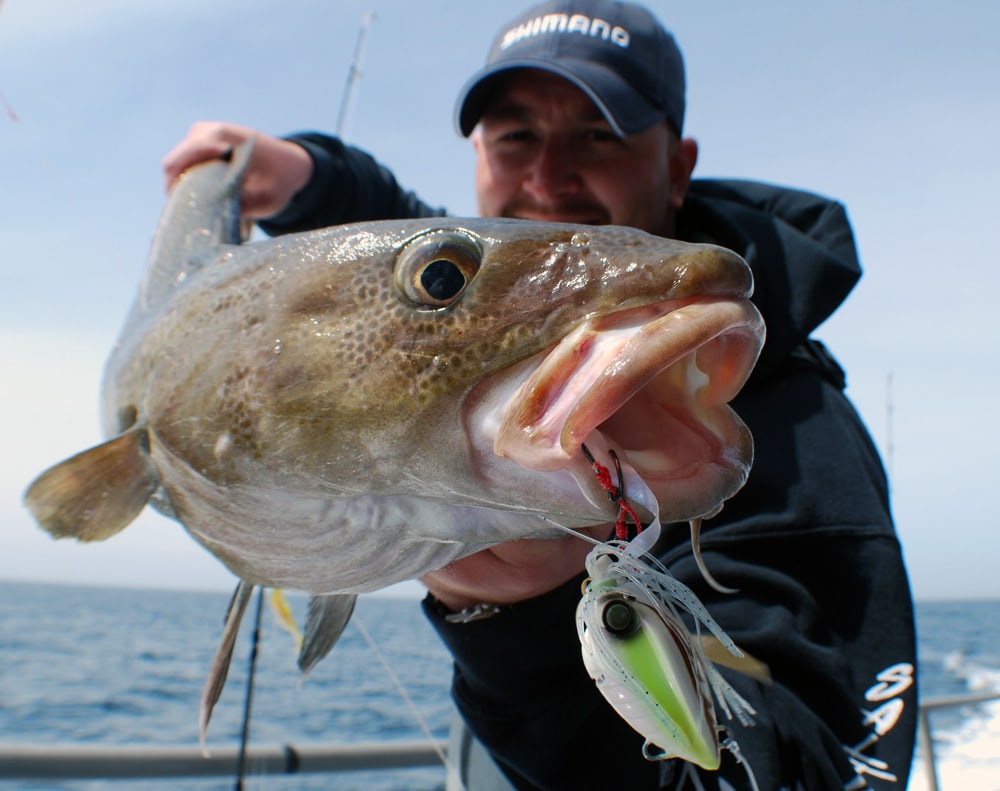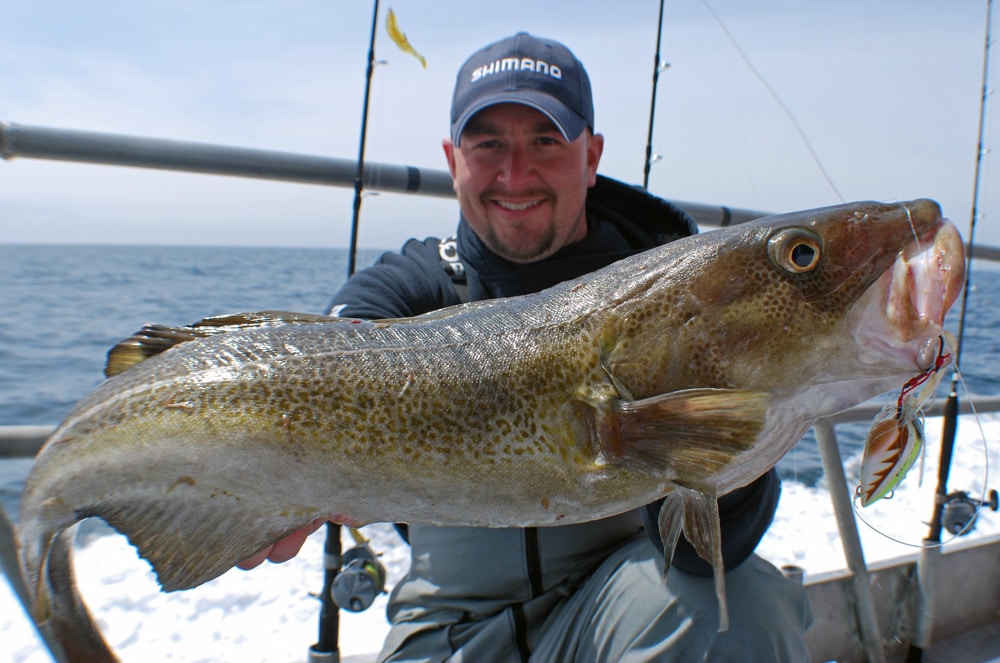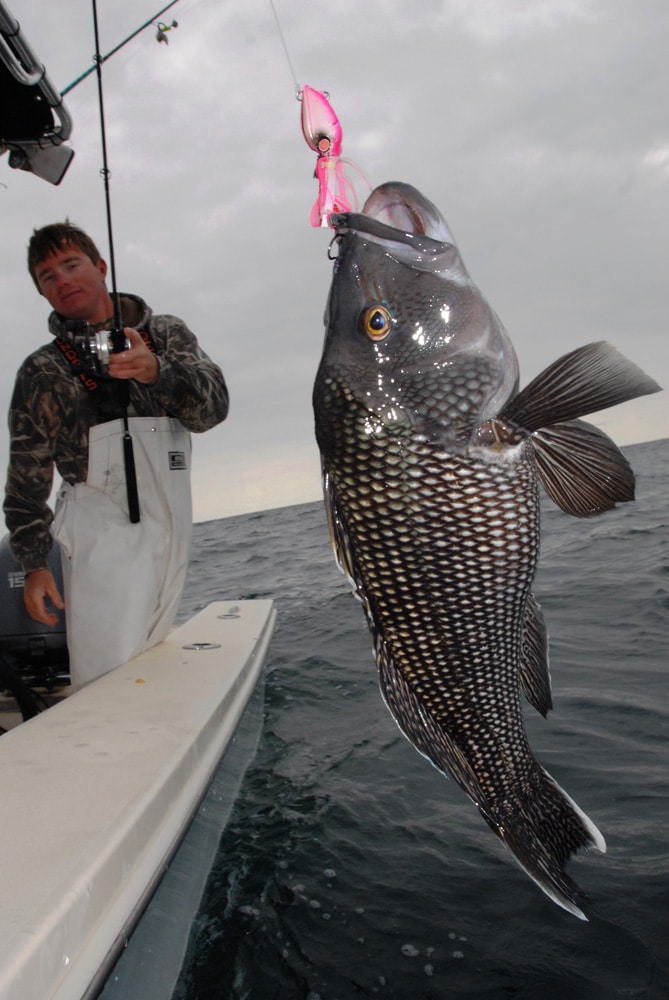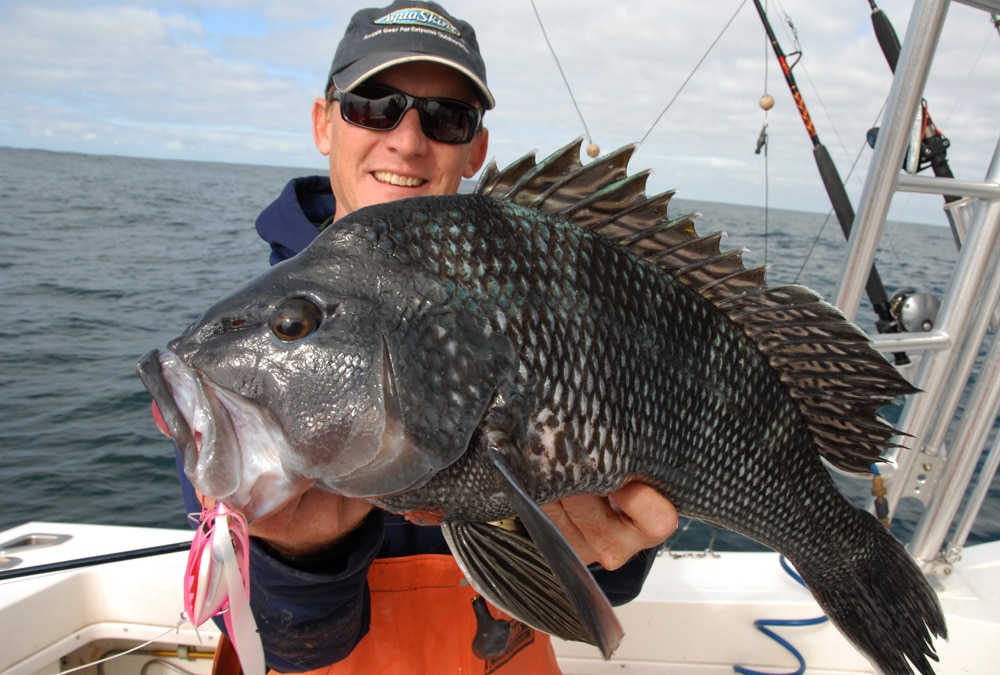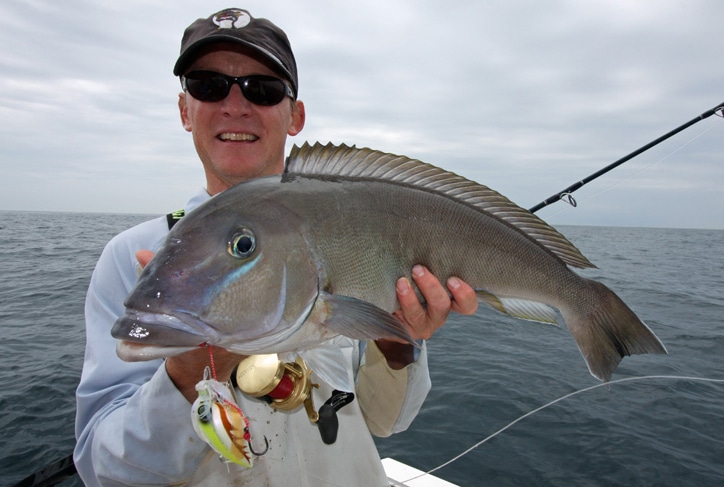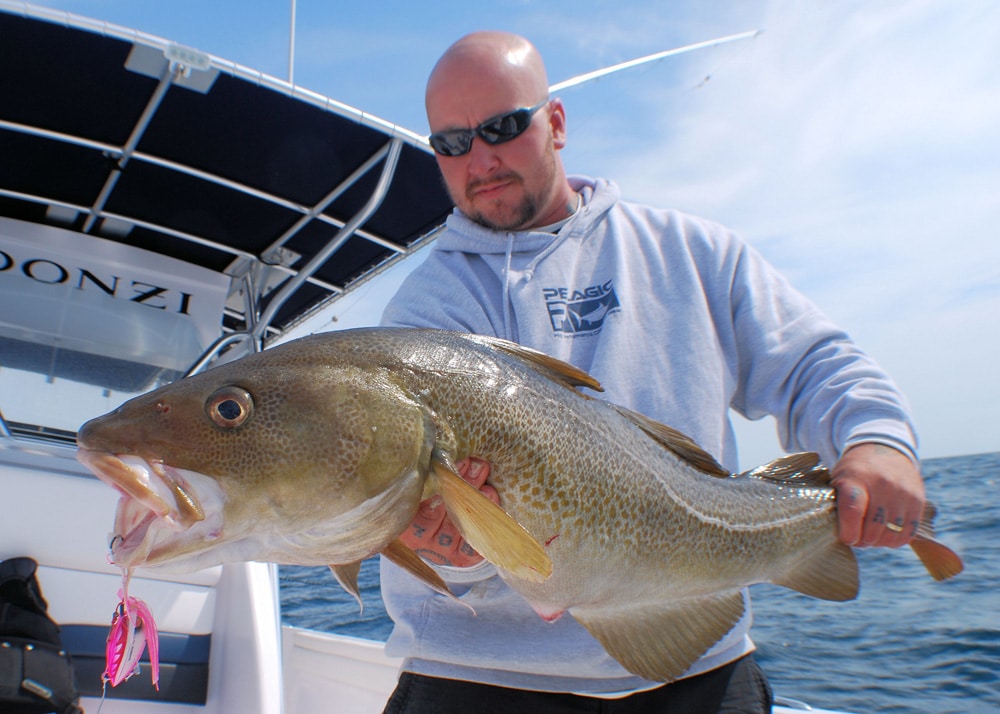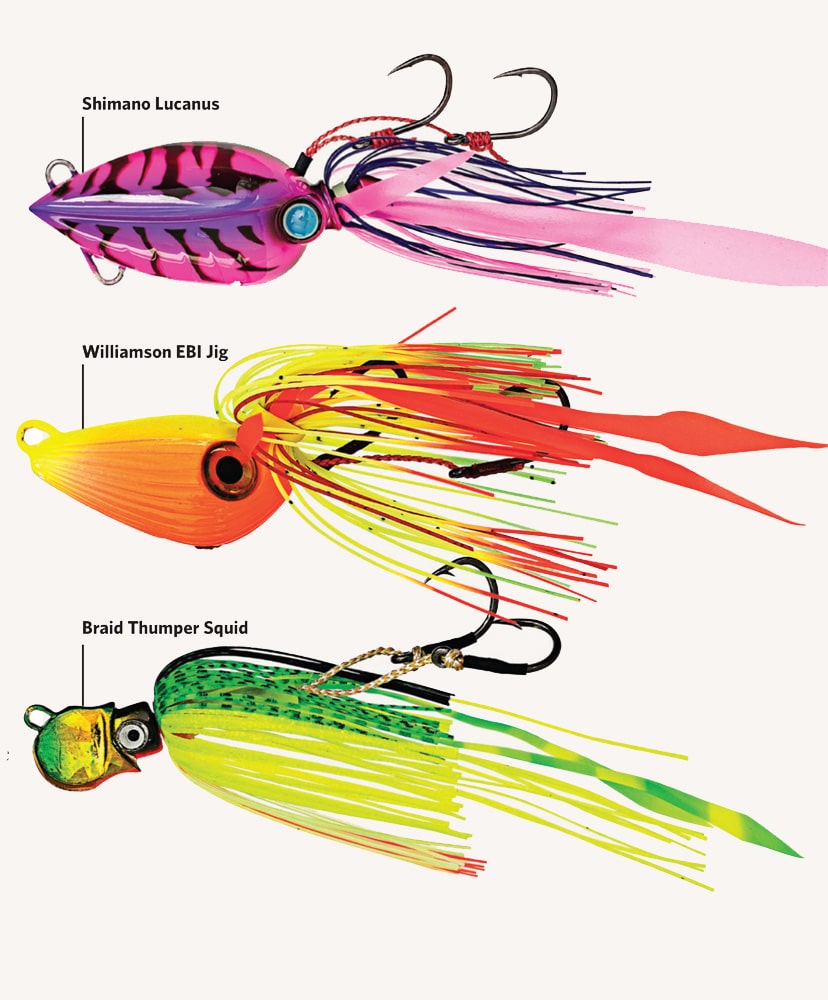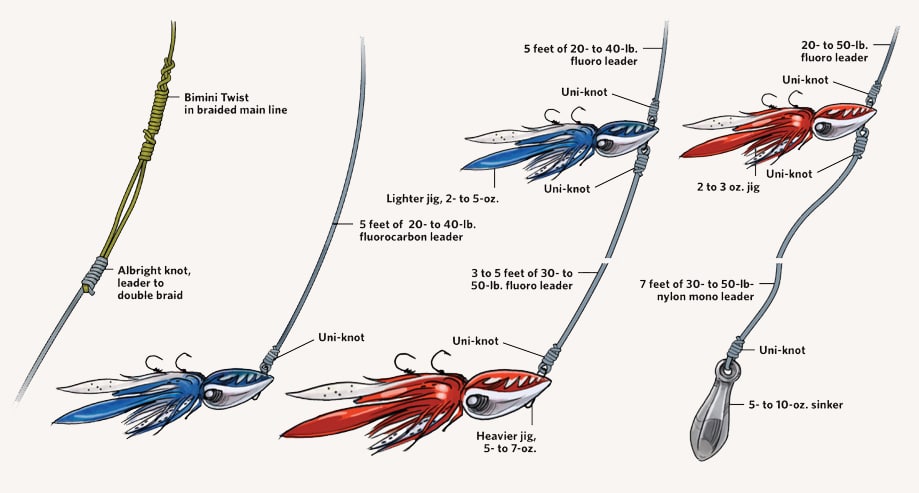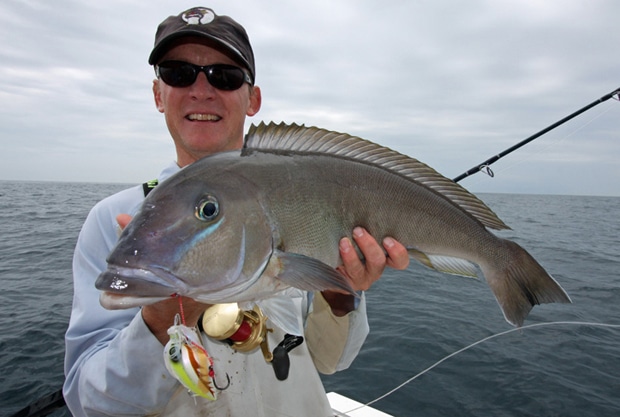
bottom fish jigs main
Most anglers target bottom species for one purpose: meat. But the days of loading the boat with sea bass, cod, rockfish and grouper are all but over. With strict regulations and tight bag limits, bottom-bouncers are lucky to take home a handful of fish. So the focus has changed from fillets to fun. Christmas-tree rigs and sash weights are out. Light tackle and high-tech jigs are in.
Enter Shimano’s Lucanus jigging system.
When I first saw Lucanus jigs, I had to chuckle. The bullet head, wild rubber skirt, and impossibly small hooks make the thing look like an alien. Then I saw the Tescata rod that goes with the system, thin as a switch and bendy as a whip. Hilarious.
“You can’t be serious,” I told Robby Gant, Shimano’s research-and-development guru, over the phone.
“It’s all about fun,” he explained. “We’re making bottom fishing fun.” Sounded tempting, so I couldn’t resist.
A few weeks later, when I showed up at the dock with my Lucanus system, my buddies did more than chuckle: They straight-up laughed at me. They called the rod a noodle, they called the jig a bug, and they called me a long list of unflattering names.
But 50 miles offshore, when I dropped the 7-ounce jig 300 feet to the bottom and hooked a fat blueline tilefish, I was the one laughing. The rod bent double, and the reel fought for every inch of line as I struggled with the 8-pound fish all the way to the surface. Who knew bottom fishing could be this much fun?
Mother of Invention
The Lucanus system, generically known as kabura jigging, originated in Japan, where commercial anglers continually up their game and their gear in order to stay competitive.
A decade ago this fishery produced vertical or flutter jigging, which Shimano introduced to American anglers as the Butterfly jig system. In similar form, about five years ago Shimano introduced kabura jigging. The result is a space-age lure that looks like it came to Earth just to fool bottomfish. And it works. As well as Shimano, a number of manufacturers are producing kabura jigs, such as Williamson’s EBI jigs and the Braid Thumper Jigs.
Systematic Approach
Shimano has perhaps the most comprehensive kabura system, which includes jigs, line, rods and reels developed to work together. Rods are ultrathin and super light with an extremely slow soft action that bends well into the handle. The grip is split, with a small foregrip and short butt. Not only does this make the rod light and ergonomic, but it increases sensitivity, since the angler’s hands contact the actual blank.
The rod blank is fiberglass for strength, and wrapped with graphite for sensitivity. A high-modulus carbon butt section reduces weight and increases sensitivity.
The reel is a tiny titan. The Tescata rods come in both spinning and conventional models. Spinning reels will drop the bait faster, while conventional reels hold more line. Either way, a Lucanus reel uses a cold-forged aluminum frame to cut size and weight. Oversize gears provide torque, and the performance drag systems create 20 to 40 pounds of pressure without taking up a lot of space. Since the diameter of braid is a fraction of nylon monofilament, more than 300 yards of 30-pound line can be packed onto a relatively small reel. In addition, the small-diameter braid allows the line to passes through the water with little resistance, so less weight is required to reach bottom. The whole system comes together to deliver a surprisingly small jig to the bottom to then retrieve a surprisingly big fish.
Action-Packed
Fishing the jigs is half the fun. While traditional bottom jigs require little more than bouncing along the bottom, kabura jigging is a game of finesse and style.
Once the jig hits the bottom, start cranking slowly to bring the jig up off the bottom. If a slow retrieve doesn’t work, try fast. Try jigging. Try a staccato retrieve. Try different retrieves until something works.
As the jig climbs through the water, the fish sees the bullet head and dancing skirt, and can’t help but bite. That’s when the second half of the fun begins.
Resist the urge to set the hook on the strike. Instead, crank slowly. The fish will nibble its way up the rubber skirt. This is when the soft rod comes into play. As the fish chews its way up the skirt, the rod bends deeper and deeper. Each bite is transmitted up the braided line, through the rod. When the rod is bowed to the hilt and the fish is tugging on the line, the hook is set: time to claim the prize.
But this is light tackle, and the fight isn’t over until the fish hits the deck. A five-pound sea bass will put this gear to the test, and a 10-pound tilefish or 15-pound grouper will wear you out. The rod bucks, line chirps off the reel, and you’ll start laughing as you try to keep it up, turning the small reel and holding tight to the rod that is bent double. That’s the fun of Lucanus.
Gear Up with Kabura Jigs
The jig, the heart of kabura jigging and the Lucanus system, in various sizes and configurations adapts to a range of conditions and species. The attachment loop on top is placed so the jig hovers horizontally. Another eye on the bottom can be rigged to a sinker or a second jig. While a single jig might not always attract fish as effectively, the single allows you to drop the jig and retrieve much faster. A 2-ounce jig will hit the bottom with light current in less than 50 feet of water. I use a 31⁄2-ounce jig down to 150 feet. From there to more than 50 fathoms, I go with a 51⁄2-ounce model. A 7-ounce model will take the jig past 100 fathoms with light current in the water column.
**Single **
Attach the jig to 5 feet of 20- to 50-pound fluorocarbon leader with a uni-knot. Use a slim beauty knot or a Bimini-Bristol combination to attach the leader to the main line, which is usually 40- to 50-pound braid.
William Osbourne, California rock cod and sand bass expert, says: “I use the lightest jig I can get away with in the current and depth. Keep it simple. Drop down to the bottom, then reel up two cranks and wait. Most bites feel like I snagged some kelp. Don’t swing, just let the rod load up.”
On Florida’s Gulf Coast, Capt. Steve Papen prefers the single rig for amberjack, snapper and grouper. “Skittish fish often hang out where the rocks meet the sand. I cast the jig, then slowly drag it back over the rocks. The little hooks and bullet head have less chance of getting snagged.”
Tandem and Drop Shot
Tie a smaller jig, 2 to 5 ounces, to the fluorocarbon leader coming off the mainline. Then attach a 3- to 5-foot length of 30- to 50-pound fluoro to the bottom eye, and tie on a heavier jig, 5 to 7 ounces.
Cod and haddock specialist Capt. Jack Sprengel, of Warwick, Rhode Island, favors this rig: “I fish the jigs drop-shot style with a 3-ounce jig five feet above a 5-ouncer. This increases the number of hooks in the water and adds weight to get the jigs to the bottom.”
In deep water and heavy current, it might take additional weight to reach bottom. Tie a 2- to 5-ounce Lucanus to the leader, attach 7 feet of 30- to 50-pound mono to the bottom eye, and add enough lead to get down. When the sinker hits the bottom, let it lie. Then, drop the jig and crank it up slowly until you feel the weight of the sinker. Drop the jig again and repeat.
Avoid the additional snagging potential of double jigs by keeping them off the bottom.
Florida Panhandle angler Sonny Granger’s amberjack, snapper and grouper technique keeps the jigs off the bottom: “We attach the jig with a loop knot, which improves the action. Also, you don’t have to drop the jig to the bottom. They work best on fish suspended in the water column.”
